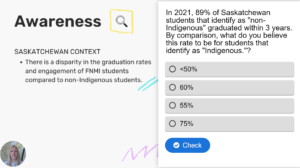Silence is Acquiescence
“What I permit, I promote. What I allow, I encourage. What I condone, I own.” – Michelle Malkin.
The above quote has been a touchstone for me as a new principal, and provides direction in the way that I want to shape the vision and direction for our school. If I truly wish to address inequity in our school system, I need to start by working with my staff. In my last post, I carefully reflected on the importance of collective teacher efficacy and my proposed actions to make a unified move to create complex change positively affect our students.
In my course shell, which you can find here, the proposed professional development is broken down into 10 professional learning sessions experienced monthly throughout the year. For this week’s assignment, I focused in on Topic 6: Silence is Acquiescence. The content within this topic explores the Inspiring Success: First Nations and Metis PreK-12 Education Policy Framework and the application of this framework to Equitable School Transformation in our local setting.
This topic can be explored synchronously (at a monthly staff meeting) or asynchronously (on the educator’s own time). There is one group activity that must be completed collaboratively, and I expect that I might have one group of commuters agree to do this activity virtually together.
The lesson starts with a self reflection where learners examine their personal and professional understanding of anti-racist and anti-oppressive education. ‘
Key terms to be explored are:
- Power
- Positionality
- Equity
The “Minds On” activity has learners score themselves on the classic privilege walk exercise, and then view my Lumi interactive video to begin the reflective process.
A side note on the Lumi app — I LOVED USING IT! It will be a wonderful reflective tool. I sincerely appreciated the ability to have open ended questions and questionnaires, however I wish that there was a way to collect questionnaire answers for later reflection. I will combat this issue likely with an anonymous google form for completion in the lesson, unless I can figure out a way to view this data before my module is released.

I also included the famous equity cartoon, but illustrating one more scenario with inclusion as food for thought.
https://twitter.com/ClinPsychDavid/status/1407103431718969345?s=20
The next part of my lesson is a collaborative Jamboard activity where we develop group norms for professional conversations about race and inequity as they might be sensitive topics for some, depending where they are on their journey towards anti-racist and anti-oppressive education. I chose to use an adaptation of the Circle of Courage model for professional collaboration by Dr. Martin Brokenleg, as all staff will be familiar with this format because we are a Circle of Courage school. This is followed by another Jamboard called Someone on my mind… which will help staff to personalize this issue to their everyday lives through a focus on a student they care about.
As a “summative assessment”, the learners will work in groups to complete the Indigenous Education Responsibility Framework for our school (The readability will be best if you download it to view in excel). This framework has been created by the Saskatchewan School Boards Association and the Strategizing Continuum includes Observing, Supporting and Disrupting, which I think is quite progressive and a bit rebellious — and I love it!
In closing, I will have students revisit “Someone on my mind…” to add the larger systemic impacts that might be made on the student in mind.
The main resources I used for this topic’s development include:
The Listening Leader by Shane Safir (THIS IS A MUST READ!!!)

In addition, I used an old PD Resource- Leading to Learn: Impacting First Nations, Inuit and Metis Student Outcomes: Signpost 1. This was a training that was put on by Student First and the STF Professional Development Unit, therefore it is tricky to share the source. If it is ever offered again — definitely sign up!
This is a big topic, and we know it is a long road. In closing, I will share one more encouraging quote, near and dear to my heart and important to my practice:
Wow, Miranda! I really enjoy your ideas for professional development opportunities. I think your staff will really appreciate the fact that you have made this content accessible online to be completely at staff meetings or on your own time. I wasn’t able to join your Google classroom, it came up with an error saying that I didn’t have the correct e-mail address (I have a Horizon School Division Google E-Mail). But in terms of your content, your post gave a great overview of what your course is all about.
Hello Megan!
Thank you for letting me know about the issue of not being able to join the Google Classroom! Speaking of accessibility this week, that barrier is something I will definitely need to address with some of my staff who have a beginning understanding of digital literacy! Thank you for the comment!
Hi Miranda, I am truly inspired by your dedication to promoting equity and addressing inequity in your school system. The quote you shared at the beginning of your blog post, “What I permit, I promote. What I allow, I encourage. What I condone, I own,” serves as a powerful reminder of the role you play as a principal in shaping the vision and direction of your school. Your commitment to working with your staff and promoting collective teacher efficacy is commendable and will undoubtedly have a positive impact on your students.
I am impressed with your thoughtfully designed professional development sessions, especially Topic 6: Silence is Acquiescence. The way you have structured the lessons, providing both synchronous and asynchronous options, shows your understanding of the diverse needs and preferences of your educators.
The inclusion of the Lumi interactive video to foster reflection and self-awareness is a great idea. It’s evident that you put a lot of thought into engaging your staff in discussions about anti-racist and anti-oppressive education through activities like the privilege walk exercise and the collaborative Jamboard sessions. Creating a safe and inclusive space for these sensitive topics is essential, and the adaptation of the Circle of Courage model is a smart approach to facilitating professional conversations. Great!!!
Hello Margarita,
I sincerely appreciate your encouragement and kind words. Your feedback is so detailed and thoughtful. Thank you!